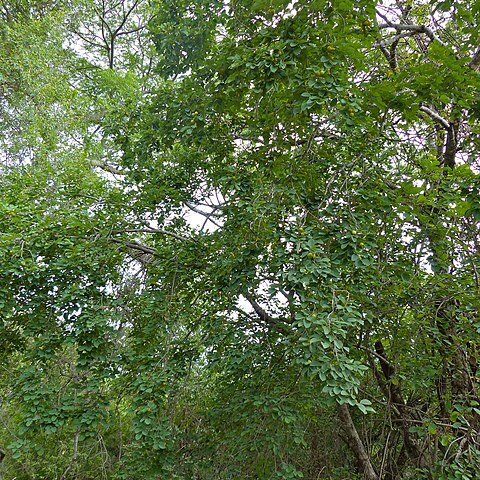Leaf blade 1.3–10(12.5) × 0.9–5.5(6) cm, broadly ovate to elliptic-ovate or sometimes ovate-lanceolate, subacute, obtuse or rounded at the apex, rounded-cuneate to shallowly cordate at the base, entire, chartaceous to thinly coriaceous, glabrous (var. glabra) to sparingly or evenly pubescent above and beneath (vars. dekindtii and polygyna) or else pubescent only along the midrib beneath and otherwise glabrous (var. maprouneifolia), pale to deep grey-green above, paler and somewhat glaucescent beneath, reddish when young; lateral nerves in 6–10(12) pairs, somewhat irregularly looped.
An attractive rounded tree. It grows 4-6 m high. It can be 12 m high. The bark is light brown and cracked. The leaves are alternate and simple. The are roundly oval. They are 2.5-8 cm long by 2-6 cm wide. They are blue green and paler underneath. The leaf stalk is 1.5 cm long. The flowers are greenish-white in clusters of a few flowers in the axils of leaves. These are 2-3 cm long. The sexes are separate on different trees. The fruit is round and 2 cm across. They are pale yellow when mature. There are 3 varieties.
Male flowers sessile; sepals (3)4–5 × (1.5)2–3 mm, ovate or elliptic, obtuse or rounded, glabrous to sparingly pubescent without, glabrous within, yellowish-green, later becoming straw-yellow in colour; disk 2–2.5 mm in diameter, pinkish; staminal column 1.5–2 mm high; anthers 1.5–2 mm long, yellow to brownish; pistillode (non-functional ovary) 0.3–0.5 mm long.
Young shoots, petioles and peduncles glabrous (var. glabra), pubescent (var. maprouneifolia) or densely fulvous-to ferrugineous-tomentose (vars. dekindtii and polygyna).Buds perulate (furnished with protective scales); perulae 1 mm long, ovate, dark brown.
Deciduous tree, up to 18 m high. Young shoots and leaves quite glabrous. Leaves simple, ovate to almost circular, green to bluish green above. Fruit spherical, 20 mm or more in diameter, pale yellow when mature. Flowers greenish yellow.
Female flowers: pedicels 1.5–2 mm long; sepals as in the male; disk 2 mm in diameter, finely toothed to coarsely and irregularly-lobed; ovary 1.5 × 1 mm, more or less ovoid, densely pubescent or glabrous; styles 1.5–2 mm long.
A deciduous tree up to 18 m tall, or rarely a many-stemmed shrub; stem usually unbranchedto 3.5 m, up to 25 cm d.b.h.; crown compact and rounded, or ± laxly spreading, the branches sometimes drooping almost to the ground.
Bark dark grey or blackish and rough, fissured and flaking in thick flakes, paler grey or whitish and smooth on the branches, cracking and flaking to reveal yellow-grey layer beneath.
Male inflorescences 0.5–2 cm long; bracts 3 × 2–3 mm, broadly ovate or elliptic-ovate, acute or subacute, strongly concave, keeled, pubescent without, glabrous within, chaffy.
Fruit 1.3–2 × 1.3–2 cm, ovoid-subglobose to depressed-globose and scarcely 2–4-lobed, glabrous or glabrescent, yellowish-green, yellow or pinkish-green.
Female inflorescences 1–3(7)-flowered, 1–2 cm long; bracts or bracteoles c. 2 × 1 mm, lanceolate, otherwise as in the male.
Seeds 7 × 5 mm, ellipsoid-ovoid, slightly shiny, light brown streaked with darker brown.
Stipules 4–5 mm long, lanceolate, pubescent without, glabrous within, soon caducous.
Flowers faintly musky-odoured, much visited by bees.
Twigs brownish, lenticellate.
Petioles 0.2–1 cm long.


